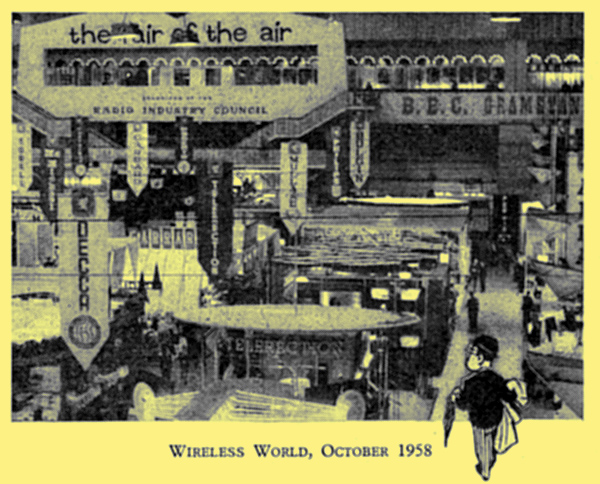|

The following passages come from the column titled Unbiased and shines a side light on the world changing from mono to stereo sound. It also illustrates the bias of a, presumably elderly, engineer of the time. The October 1958 edition featured a review of that year's Radio Show. The experimental stereo radio broadcasts of the time needed two or three receivers, and the same number of transmitters as the multiplex system had yet to arrive.
Stereobatics
Many radio shows of the past, had a catchword summarizing some new development, and at this years show the word 'stereo' beat all records - except 'television' at the 1936 Show.
These catchwords often pass into oblivion and sometimes the development which they describe perishes with them. An instance of this is push-button tuning which now survives mainly in the form of a method of waveband changing. In some instances, the word is forgotten but the principle survives, as in the case of 'bandpass' which dominated the 1930 exhibition. Where now do you hear that word except in technical circles; and yet the principle of flat-topped tuning is a commonplace of all sets.
It is difficult to say into which of these two categories stereo is going to fall but if manufacturers want the public to buy stereo reproducing equipment I think they will have to alter their methods of demonstrating it. I am not criticizing them for their stereobatics with trains and ping-pong balls but for their failure at the Show to demonstrate the difference between stereo and non-stereo. I refuse to use the foolishly inaccurate word 'monaural' to describe ordinary non-stereo reproduction, as surely monaural listening is impossible for a person with normal binaural hearing, unless, of course, he deliberately plugs one ear. The correct antonym for the Greek- derived word 'stereo' is obviously 'astereo'.
In my opinion each demonstration assembly should have been provided with a simple switching arrangement whereby the two loudspeakers could have been instantly connected in parallel to the output of one channel, and I hope that dealers will do this in their demonstrations. The only firm which adopted this method was one which was demonstrating stereo on earphones and the difference between 'parallel' and 'stereo' was very striking indeed.
One last word and that is a prophecy. In a few years time the catchword of the show will be video. We shall then have available in the shops video recordings on magnetic tape (a domesticated VERA) and also on discs. These records will be played on units which we can connect to the video 'pickup' terminals which our TV sets will then have. In this way we shall be able to have bottled plays and other things on our TV screens during non-broadcasting hours.
Our amateur cine films will then be processed as reels of magnetic tape and they, too, will be shown in this manner. Our radiogramophones will thus have their visual counter-parts in these 'radiogramoscopes'.
The Triumphant Disc
Almost overnight the disc stereogram has arrived. A couple of years ago two channels on one disc was unknown except in the laboratory. The really surprising thing, however, is the popularity it has achieved compared with that of the tape stereogram which has been with us for quite a few years now.
There does not really seem to be much distinction between the two systems on the ground of cost. Each one uses its own special type of driving mechanism and pickup, and each uses a two-channel amplifier and output. Despite this, a tape stereogram seems to be a luxury and therefore only purchasable by the large pay packets of dukes, dustmen and other grades of unskilled labour. Ordinary people like you and me have to be content with twin-track discograms. I wonder why this is so? I wonder, too, why the tape stereogram, when it first came out, never received the wide publicity which the twin-track discogram is now getting?
'Pop' record availability is another thing in which the disc machine is already ahead despite the two or three years start of its tape counterpart. However, apart from questions of price, publicity and 'pop' record availability I think one of the main reasons for the popularity of the disc compared with tape is the handiness of the former type of record when compared with the tedious threading-up needed by the latter. The amateur cine world solved this threading-up problem long ago with the handy film magazine.
There is in my opinion, only one respect in which the tape scores over the disc and that is in its non-mechanical method of picking the programme off the sound track. One day I feel sure that discs will be recorded and reproduced electromagnetically.
Stereo Radiograms
We have presumably to get used to new words like 'stereogram' to designate the new instruments capable of playing the new stereo discs. Some of these stereograms are combined with a radio set to form a radio-gram; in fact, these are ordinary radio-grams with a special pickup, and an extra amplifier and loud-speaker for the second channel. I have heard several people describe these as stereo radio-grams and the sooner this incorrect designation is quashed the better, for that is definitely what they are not. If in a few years time the BBC regularly transmits stereo sound programmes we shall undoubtedly need the word 'stereo-radio-gram' to describe the instruments we shall then be using.
It is obvious, I think, that a stereo-radio-gram when it arrives will be an instrument having not only two AF channels as in the present-day stereo-gram, but two RF channels also so that stereo broadcast transmissions could be received. It would be quite easy for a manufacturer to make a true stereo radio-gram with two RF channels now, but without BBC. stereo transmissions it would be as useless as the '16' speed is on our gramophones with no records available save talking books for the blind.
|